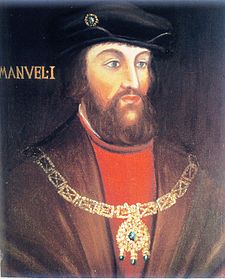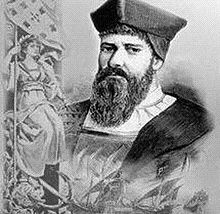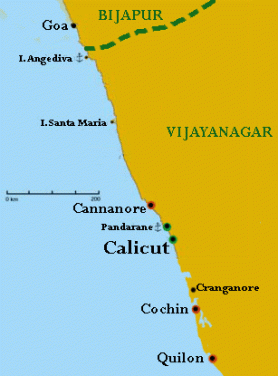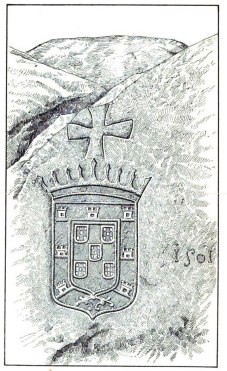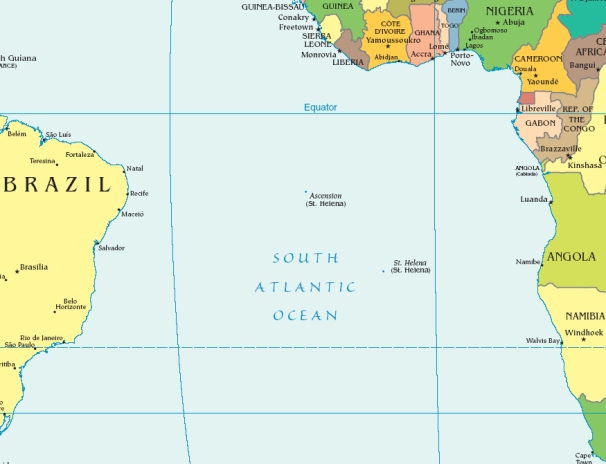King Manuel I was a Portuguese king who bought fame by expanding the Portuguese empire overseas. He succeeded John II who was his brother in law to the throne. He continued the policy of aggressively expanding Royal Commerce laid down by John II.
Bartalomeo Marchionni was a wealthy and resourceful Florentine merchant residing in Lisbon. He took up keen interest in the spice trade with India after Vasco da Gama’s super profitable voyage. He already had an established monopoly over the sugar trade in Portugal, he however had shifted his attention and greed to the profits coming from the trade in Indian spices. His only problem was that the Portuguese crown had decided to expand only royal commerce and not involve private traders in their visits to India. Bartalomeo started building up his contacts during the second invasion of India led by Cabral by financing the ship building operations and thus sponsoring 5 out of the 13 ships. His generous donations earned him respect and admiration among the Portuguese aristocracy and feudal lords. He befriending one such feudal lord by the name of D. Álvaro of Braganza. Dom Alvaro was very close to the royal family and especially King Manuel. Dom Alvaro convinced King Manuel to allow Bartalomeo to conduct a exploration in partnership with crown. King Manuel though reluctant at first later agreed to do so.
Joao da Nova was an Atlantic explorer in service under the Portuguese Crown. He was appointed the commander in chief of a comparatively smaller fleet of a purely commercial intent, sponsored by Baratalomeo Marchionni and Dom Alvaro. This was the 3rd Aramada of the Portuguese to India. It consisted of just 5 ships of which one was a supply ship. Its agenda was wholly commercial. Out of the 5 ships only one was owned by the crown the rest by the Marchionni-Alvaro consortium. It carried 500 men of which only 70 were armed. The mission departed on the 10th of March 1501. Their destination was Calicut the principle spice port. The mission was under the assumption that the previous one led by Cabral would have made a good base in India what they did not know was that instead of making good relations and base it had infact increased the hostilities of the Indians towards the Portuguese. The 3rd Armada was sailing into a war, which they were not ready for nor expect. The departure could not have been delayed till the return of the previous mission due to the pattern of the trade winds.
They reached Cape of St Augustine in May 1501 and crossed the Cape of Good Hope on July 7 1501, and anchored at Mossel bay some days later. Here they found letters left in boots hung to a tree by Pêro de Ataíde of Cabral’s mission stating of the newly developed hostilities in Calicut. He also stated some more detailed information was left in Malindi by Cabral himself. Also in the letters was mention of two newly found ports of Kochi and Cannanore which were friendly towards the Portuguese and also favorable for spice trade. As per the prior decisions one of the 5 ships was to head out to Sofala but Nova decided otherwise and decided to head out together towards India. In Mid July they stopped near Kilwa and took onboard some citrus fruits for their scurvy sick crew. The mission then made another halt in Malindi and then head off towards Cannanore.
The mission reached the Santa Maria islands off the Indian coast in August 1501. Nova the proceeded to the trade port of Bhatkal of the Vijaynagar empire. He brokered a deal with the feudal lords present there and in return received few of their military units to help them against The Zamorin. Nova started his journey towards Cannanore. Midway he encountered 2 trade ships belonging to The Zamorin and captured them by force and took them along. In November 1501 the mission finally arrived in Cannanore. The Kolathiri of Cannanore gave him a grand welcome and asked them to immediately load up the spices before the news of their arrival reached Calicut. However Nova decided otherwise and headed towards Kochi to collect the supplies from the factory set up there. Nova left behind a small group of men as factors in Cannanore to negotiate and explore the spice market till he returned from Kochi. He decided to leave behind a trading group belonging of Marchionni-Alvaro consortium.
Before he could set sail to Kochi the news of his arrival had reached The Zamorin and he sent an embassy accompanied by a Portuguese survivor of the previous mission. The Zamorin stated that he was apologetic of what happened in the previous year, expressed his desire for increased trade ties and blamed it all on the Arab traders. He also asked Nova to come to Calicut collect the wares left behind by the previous mission and also some compensation for the same. The survivor however advised Nova to not trust a single word of The Zamorin. The Kolathiri however fearing the wrath of The Zamorin asked Nova to trust him and accept the great offer.
Nova set sail towards Calicut and anchored in the waters in plain view of the city. By this time Nova’s fleet had grown to 7 ships. While anchored near Calicut a Portuguese survivor from last year visited the ships and warned Nova to not trust the Zamorin, Nova grew suspicious of Zamorin’s plans. He decided to flee but after a show of strength, he attacked three merchant ships including one owned by Zamorin himself. He captured them and the booty filled with sliver and spices. He set fire to a fourth ship and sailed off towards Kochi with now 10 ships. He however came to an unpleasant scene there as well. Cabral had left behind Barbosa a trader in Kochi he informed Nova that Cabral had betrayed the Ruler of Kochi by kidnapping 4 women from a noble household while leaving. The ruler of Kochi and the Arab traders had issued a boycott on all Portuguese products and had started accepting payment for spices in sliver alone. Nova was running short on silver and only had cloth to trade with. He and Barbosa then headed back to Cannanore with the fleet of 10 ships.
The trading group in Cannanore was facing the same problem as Portuguese wares were going unsold. Nova requested Kolathiri to intervene and help them secure a consignment of spices. Kolathiri gave credit to Nova and he himself remained as security for the payment which Nova promised to make on his next voyage. When Nova looted Zamorin’s ship he along with the booty also came across some navigational maps. It showed the location of an island called Ceylon famous for cinnamon. If all trade talks had failed Nova had planned to go to Ceylon to try his luck there. However after Kolathiri’s personal intervention he decided to set sail back to Portugal. Just when he was about to set sail the news came in that Zamorin enraged on Nova’s behavior had sent a fleet of 20 warships 20 ships and close to 180 longboats all together adding upto 2000 men to attack the Portuguese Armada. Kolathiri advised Nova to stay back and told him that Zamorin will not attack till he is under the protection of Cannanore. However Nova decided otherwise, he was fed up of the misunderstandings and decided to tackle the problem head on. Nova decided to pierce the attack in a column formation. He loaded all the goods in the Portuguese vessels and used the Malabari captured vessels as a shield to get through. In a confrontation that lasted for 2 days Nova lost 7 of the 10 ships and more than half his crew. He however managed to get across.
He had lost half of his consignment, and also owed a handsome amount to the Kolathiri. He decided to try his luck and headed south in search of Ceylon on January 2 1502. He managed to intercept a Calicut merchant ship off the coast of Ceylon, he captured the cinnamon from the ship and burnt the remnants of the ship and crew. He further headed towards Ceylon. He managed to squeeze a trade alliance with the Tamil traders of nothern Ceylon. He started his return voyage after exchanging cloth for cinnamon in late February 1502.
After crossing the Cape of Good Hope in May 1502 Nova ran shore and found an inhabitated island and named it St Helena. He built a chapel there and also dug a freshwater well. For the next 120 years this would be a routine Portuguese halt enroute India and also a very well guarded secret from others. Nova reached Lisbon in September 1502. This mission was not as profitable as the previous ones and had made the Lisbon traders realize that Trade would not be as easy and profitable as earlier. The acceptance of trade in only silver also was a new development.
However King Manuel had already flagged off the Revenge Fleet to attack India. The newly found information was not handed over to the Revenge Fleet (4th Armada).
